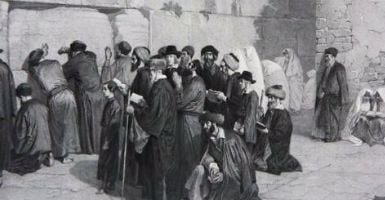Poskim rely on the input of experts and specialists to issue rulings on matters of Halacha that require particular experience and expertise. For example, a physician’s opinion is crucial in determining whether a sick person is fit to fast on Yom Kippur and a gynecologist will often be consulted in cases where it is necessary to determine whether a woman is a Nida.
The Rishonim discuss the testimony of physicians and to what degree, if any, it can be relied upon. The arguments are fascinating; this essay will examine various perspectives on the issue.
There are two Sugyos in the Gemara that discuss relying on the opinion of physicians. We will focus on one of them.
Nida 22b
R’ Elazar bar R’ Tzadok said: My father raised two incidents from Tivin to the Sages in Yavneh [for discussion]. [The first was] an incident involving a woman who would [repeatedly] discharge objects similar to red shells, and they came and asked my father [whether this rendered her impure]. My father asked the Sages, and the Sages asked physicians [what the shells were]. The physicians replied: This woman has a wound in her uterus from which she discharges these shells [they are scabs of the wound and not congealed blood[1]]. She should cast them into water [to determine what they are]. If they dissolve [it is blood and] she is impure.
There was another incident involving a woman who would discharge objects similar to red hairs. She came and asked my father [whether she was impure]. My father asked the Sages, and the Sages asked physicians. The physicians replied: This woman has a mole in her uterus from which she discharges objects similar to red hairs [in other words, the mole grows hairs, which are being discharged]. She should cast them into water [to determine what they are]. If they dissolve [it is blood and] she is impure.
This Gemara implies that the Chachamim needed to ask physicians when encountering a phenomenon that they did not understand, and that they could rely upon their responses. (However, it is important to note that R’ Elazar bar R’ Tzadok first asked the other Chachamim, before turning to physicians. The Chachamim have a tradition about certain phenomena, about which they do not need to consult with physicians.)
This is clearly the view of the Rashba (Shu”t Chadashos 89), who was asked about a woman with post-coital bleeding (see below), which would render continued marriage to her husband forbidden. The question was whether they could rely upon the contention of physicians who claimed they had successfully treated other women [with the same condition] and that they could treat her. The Rashba replied briefly:
If one of them is an expert physician it would seem that it is possible [to permit her to remain married to her husband and undergo the recommended treatment]. For we have already seen our teachers rely upon physicians with regard to a woman who discharges [red] hairs, as stated in Perek haMapeles.
However, the interpretation of the aforementioned Gemara is actually a matter of dispute. While the physicians gave their opinion as to the nature of the red shells and red hairs, the Gemara also relates that the discharged objects were to be placed in water to scientifically determine whether they were blood. It does not clearly state who made this recommendation. If it was part of the physician’s recommendation, this Gemara can indeed prove that a physician’s opinion can be relied upon in Halacha, as the Chachamim were relying upon the physicians’ assertion that the discharge could be identified by examining whether it dissolved in water. However, it is just as likely that it was the Chachamim’s recommendation, based on a tradition. Thus, despite the fact that the physicians were certain that the discharge was not blood, the Chachamim did not rely on their view alone and conducted a definitive experiment in addition.
Furthermore, even if it was the physicians’ recommendation [to place the discharge in water], we cannot prove that one should rely upon physicians in all circumstances. Perhaps Halacha only accepts their opinion if it can be proven through an experiment or test that allows us to see the results ourselves.
The Beis Yosef (Y.D. 191) cites the Ran who discusses the case of a woman who sees a small trace of blood in her urine. Can we attribute the blood to something other than menstruation or is she considered a Nida? According to the Ran, since physicians contend that a small trace of blood usually comes from the kidney and is not menstrual blood, she should not be considered a Nida.
With regard to the Ran’s citing of physicians to support his position, the Beis Yosef cites the aforementioned Gemara in Nida, and comments:
The physicians’ reason was that a woman does not usually discharge red shell-like or red hair-like objects. Therefore, they claimed that they must certainly have come from a wound or mole in her uterus. Though she does not feel any wound or mole in her uterus, we do not pay attention to this. Here too, since physicians know that a small trace of blood usually stems from the kidneys, we may assume that it came from them and are not concerned.
Clearly, according to the Beis Yosef, the Gemara in Nida proves that one may rely on physicians without reservation. He does not discuss the experiment outlined by the Gemara, and in fact, in the case of the Ran, there was no equivalent experiment.
If one may rely upon physicians, why did the Chachamim conduct a test at all? The Acharonim offer two answers:
- Perhaps the physicians themselves were not convinced that the discharges came from a wound or a mole and only surmised as such since women do not usually issue these kinds of discharges. Therefore, the Chachamim decided to conduct an additional test. However, in a case where the physicians are convinced of their view, we can rely upon them exclusively. (Sidrei Tahara[2] 188:5, in explanation of the Beis Yosef. He adds that this was the position of his father-in-law, the Shev Yaakov[3].)
- Perhaps the physicians were not convinced that the discharges came from a wound or mole and they therefore suggested themselves that a test be performed (in other words, it was not the Chachamim’s suggestion to perform the test). However, in a case where physicians are convinced of their view, no tests are required. (Pischei Nida citing Acharonim.)
The Darchei Moshe, by contrast, maintains that the Gemara in Nida proves that one may not rely on the view of physicians, which is why the Chachamim conducted a test, even after the physicians stated their position.
The Rosh (Shu”t 2:18) asked the following of the Rashba:
My teacher should also enlighten me by explaining the Gemara in Perek haMapeles (Nida 22b)… It is difficult to me. Since the blood came from a wound, why was she impure? Surely, it is stated in Perek Kol haYad (ibid. 16) that if a woman discharges blood from a wound, even if it is during the days that she regularly menstruates, she is pure… We see that even if blood comes from the Mekor (the cervix), she is pure since it came from a wound.
In other words, the Rosh could not understand the purpose of placing the discharge in water to determine whether it was blood. Since the doctors asserted that the woman had a wound, and blood from a wound (“Dam Maka”) does not render a woman a Nida even if it comes from the Mekor, what would be gained by conducting the test? Even if it was determined to be blood, the woman should not be considered a Nida!
The Rosh clearly understood that the physicians’ assertion that the woman had a wound was not being challenged. He thus questioned the purpose of the test, for it could only ascertain whether the discharged matter was blood and not whether there was a wound. According to the Rosh, the test was not conducted to verify the physicians’ claim.
The Mahram Lublin (111) disputes the Rosh’s assumption. He maintains that the test was conducted to verify the physicians’ claim. If the discharges were determined to be blood, we would be concerned that it is menstrual blood and would consider the woman Tamei (on the basis of a Safek as to whether the blood was Dam Nida or Dam Safek).
The Sidrei Tahara (ibid.) points out that even if we accept the premise of the Maharam Lublin, namely, that the Chachamim conducted a test to verify the physicians’ claim, this does not prove that we never rely on physicians. Rather, it depends on whether there is a test we can conduct to verify their claims. If there is no viable test, we would accept their view.
The Chacham Tzvi (46) asks an obvious question on the approach of the Maharam Lublin. If, the Chachamim do not rely on the physicians in the scenario where a confirmatory test is possible, why did they ask the physicians for their opinion in the first place?
The Sidrei Tahara answers that the Maharam must hold like the Ra’avad (Sha’ar haPrisha, in dispute with the Razah) that one can only attribute dry blood to a source other than the Mekor if physicians ascertain that it is theoretically possible for a wound in the uterus to scab causing a red, shell-like discharge. Thus, the purpose of asking the physicians for their view was not to rely on it in this case, but to ascertain whether a possibility exists for a discharge of this sort to be attributed to something other than menstrual blood.
This could also explain why the Rosh did not consider this possibility. The Rosh holds like Rabbenu Zerachia haLevi (Nidah 3:3) who argues with the Ra’avad and holds that one may attribute dry blood to a source other than the Mekor, even if physicians have not stated that this is a possibility. If so, there would seem to be little point in the Chachamim asking the physicians for their view if they were planning on conducting a test in any case.
At this point, we have discovered that while the Acharonim do not entirely agree that the Gemara in Nida is proof that one should rely on the view of physicians, the Rishonim appear to hold a more straightforward position (that one may adduce proof to this from the Gemara).
This is also the position of the Maharik in his discussion of Chafifa (the preparation of the body before immersing in a Mikva). The Chachamim forbade the use of certain substances that cause the hair to become entangled prior to immersing. The Tur broadens this to “any substance that can cause the hair to become entangled” (Y.D. 199). The Beis Yosef cites the Maharik (Shu”t, Shoresh 159) who rules that we cannot forbid any more substances other than those recorded by the Gemara. The Maharik therefore permitted a woman who had been forbidden by physicians to wash her hair with water, to use wine instead and not be concerned that it would cause her hair to become entangled. However, the Beis Yosef adds:
Nevertheless it is appropriate that before a woman does so, she should conduct a test, and wash her hair with wine and see whether it becomes entangled, or breaks, or becomes hardened to a greater extent with wine that with water. If she conducts this test three times and sees that the wine does not cause these effects any more than water, she may rely on this [testing] and act in this way. It would also be correct for her to ask the doctors who warned her against using water whether hot wine is likely to cause her hair to become entangled, break, or harden more than hot water. We find that the Chachamim always relied upon the words of physicians, such as with regard to Nida (22b) and a sick person on Yom Kippur (Yoma 83a).
In other words, according to the Maharik, one may rely upon the view of physicians even with regard to Dinim d’Oraisa (such as the Halachos of Chatzitza) for “we find that the Chachamim always relied upon the words of physicians.” He bases this on the Gemara in Nida, and, although he does recommend conducting tests to verify the physicians’ position, he does not hold that this is critical.
Ro’ah Machmas Tashmish
We quoted the Rashba’s ruling regarding a woman who experiences post-coital bleeding (“Ro’ah Machmas Tashmish”). A Ro’ah Machmas Tashmish has a “disease” that causes her to emit menstrual blood each time that she engages in intercourse. She is forbidden to her husband at all times, even if she has immersed in a Mikva, because cohabiting with him will cause her to become Tamei. (See Y.D. 187 for the details of the number of times that post-coital bleeding must occur in order to be considered a Ro’ah Machmas Tashmish).
Can a Ro’ah Machmas Tashmish be cured? Indeed she can (Nida 66a). May we rely upon physicians who claim that they are able to cure a Ro’ah Machmas Tashmish? According to the Rashba we may.[4] According to the Ritzva (one of the Ba’alei haTosfos, cited by the Beis Yosef, Y.D. 187) there is one condition:
If the physician says she can be healed – she may engage in relations based on his word if he is a Yisrael. As the Yerushalmi states (Shabbos 6:2), “A physician is trusted to attest that a Kemaya is effective and that he has cured people with it three times”… However, I cannot permit it based on the words of a Nachri, even if he is a publicly acknowledged expert physician who would not wish to risk his reputation by issuing a mistaken diagnosis. This is because we can apply the Pasuk, “Their mouths speak falsehood” (Tehilim 144:8). However, if she sees that her menstruation stops by means of the treatment, and it is clear that it has been effective, it would appear that she may even rely on the word of a Nachri for there is a cure for this disorder (Nida 66a).
In short, one may rely upon a Yisrael but not a Nachri, even if he is an expert physician. However, if there are clear indications that she has been cured she may rely upon a Nachri.
Why does the Ritzva adduce proof from the Yerushalmi and not the aforementioned Gemara in Nida? Perhaps it is due to one of the arguments outlined above, that question whether proof can be adduced from the Gemara in Nida given that the Chachamim performed a test even after the declarations of the physicians. However, having proved his point from the Yerushalmi, it is likely that he would explain the Gemara in Nida like the Rashba, Rosh, and Maharik, namely, that the Chachamim did indeed rely upon the physicians’ opinion.
Not all of the Poskim agree to the Ritzva’s ruling in every case. The Tur cites the Sefer haTeruma (107) who questions whether one may rely on a physician in the case of a woman who has been confirmed to be a Ro’ah Machmas Tashmish.
The Shulchan Aruch rules (ibid. 8):
If she wants to be cured [and be permitted to her husband] it needs to be before she is confirmed [as a Ro’ah Machmas Tashmish]. But after it is confirmed, some question whether she may rely on the treatment to engage in relations afterwards. Some permit it if a Jewish doctor says to her “you are cured”. If she sees that her menstruation stops by means of the treatment, and it is clear that it has been effective, it would appear that she may even rely on the word of a Nachri.
The Shach (ibid. 28) cites the Bach who rules that a physician who succeeded in curing a woman whom he started treating before she was confirmed as a Ro’ah Machmas Tashmish (in which case one may certainly rely on him), can also be relied upon with regard to a woman who has already been confirmed to be a Ro’ah Machmas Tashmish.
The Gra sides with those who hold that one may rely upon a physician’s word even after a woman is confirmed as Ro’ah Machmas Tashmish.
The second essay in this series will review the final Halacha of a Ro’ah Machmas Tashmish, explore several other related Sugyos, and summarize the various approaches to this topic in general. Among other issues, we will tackle the basic question of why would we not rely on the opinion of physicians, and examine whether this question is connected to the Halachos of Eidus (testimony).
To conclude, we will cite a fascinating ruling of the Chasam Sofer (Shu”t Y.D. 175) that includes several important, related principles. He questions why the Bach creates a convoluted case of a physician who has successfully treated a woman who is not yet confirmed to be Ro’ah Machmas Tashmish. Why does he not use a simpler, and apparently more relevant, case of a physician who has successfully treated a confirmed non-Jewish Ro’ah Machmas Tashmish? He answers that one cannot draw conclusions from research that has been conducted on Nachrim.
This is an extremely important principle. What is his source for this contention? He cites a Gemara in Shabbos (86b) that states that semen becomes putrid inside a woman three days following intercourse (this has practical relevance with regard to Tuma). However, the Gemara states that there may be a difference between a Jewish woman and a non-Jewish woman since a Jewish woman observes Torah and Mitzvos and the drive to constantly observe the Mitzvos “heats up her body”, thus it may have a different constitution. Alternatively, a non-Jewish woman’s body may have a higher temperature because she eats bugs and insects that heat up the body. The Chasam Sofer concludes from this Gemara that a Jewish person may have a different biological constitution than a non-Jewish one![5]
[1] Rashi ad. loc., s.v. Klipos
[2]R’ Elchanan Ashkenazi (1713-1780), Rav of Danzig, Poland
[3] R’ Yaakov b. Binyamin Poprash Katz (d. 1740), Rav and Av Beis Din of Frankfurt-am-Main.
[4] The Rashba, as quoted above, did not inquire as to the number of times the woman in question had emitted blood due to sexual relations. This implies that he permitted them to rely on the opinion of physicians in all cases.
[5] One could wonder what the status of medical research conducted on non-observant Jews would be.














